Kaishun Wu
DSA and IoT, Hong Kong University of Science and Technology, Guangzhou
DACA-Net: A Degradation-Aware Conditional Diffusion Network for Underwater Image Enhancement
Jul 30, 2025Abstract:Underwater images typically suffer from severe colour distortions, low visibility, and reduced structural clarity due to complex optical effects such as scattering and absorption, which greatly degrade their visual quality and limit the performance of downstream visual perception tasks. Existing enhancement methods often struggle to adaptively handle diverse degradation conditions and fail to leverage underwater-specific physical priors effectively. In this paper, we propose a degradation-aware conditional diffusion model to enhance underwater images adaptively and robustly. Given a degraded underwater image as input, we first predict its degradation level using a lightweight dual-stream convolutional network, generating a continuous degradation score as semantic guidance. Based on this score, we introduce a novel conditional diffusion-based restoration network with a Swin UNet backbone, enabling adaptive noise scheduling and hierarchical feature refinement. To incorporate underwater-specific physical priors, we further propose a degradation-guided adaptive feature fusion module and a hybrid loss function that combines perceptual consistency, histogram matching, and feature-level contrast. Comprehensive experiments on benchmark datasets demonstrate that our method effectively restores underwater images with superior colour fidelity, perceptual quality, and structural details. Compared with SOTA approaches, our framework achieves significant improvements in both quantitative metrics and qualitative visual assessments.
Period-LLM: Extending the Periodic Capability of Multimodal Large Language Model
May 30, 2025



Abstract:Periodic or quasi-periodic phenomena reveal intrinsic characteristics in various natural processes, such as weather patterns, movement behaviors, traffic flows, and biological signals. Given that these phenomena span multiple modalities, the capabilities of Multimodal Large Language Models (MLLMs) offer promising potential to effectively capture and understand their complex nature. However, current MLLMs struggle with periodic tasks due to limitations in: 1) lack of temporal modelling and 2) conflict between short and long periods. This paper introduces Period-LLM, a multimodal large language model designed to enhance the performance of periodic tasks across various modalities, and constructs a benchmark of various difficulty for evaluating the cross-modal periodic capabilities of large models. Specially, We adopt an "Easy to Hard Generalization" paradigm, starting with relatively simple text-based tasks and progressing to more complex visual and multimodal tasks, ensuring that the model gradually builds robust periodic reasoning capabilities. Additionally, we propose a "Resisting Logical Oblivion" optimization strategy to maintain periodic reasoning abilities during semantic alignment. Extensive experiments demonstrate the superiority of the proposed Period-LLM over existing MLLMs in periodic tasks. The code is available at https://github.com/keke-nice/Period-LLM.
Efficient Mixture-of-Expert for Video-based Driver State and Physiological Multi-task Estimation in Conditional Autonomous Driving
Oct 28, 2024



Abstract:Road safety remains a critical challenge worldwide, with approximately 1.35 million fatalities annually attributed to traffic accidents, often due to human errors. As we advance towards higher levels of vehicle automation, challenges still exist, as driving with automation can cognitively over-demand drivers if they engage in non-driving-related tasks (NDRTs), or lead to drowsiness if driving was the sole task. This calls for the urgent need for an effective Driver Monitoring System (DMS) that can evaluate cognitive load and drowsiness in SAE Level-2/3 autonomous driving contexts. In this study, we propose a novel multi-task DMS, termed VDMoE, which leverages RGB video input to monitor driver states non-invasively. By utilizing key facial features to minimize computational load and integrating remote Photoplethysmography (rPPG) for physiological insights, our approach enhances detection accuracy while maintaining efficiency. Additionally, we optimize the Mixture-of-Experts (MoE) framework to accommodate multi-modal inputs and improve performance across different tasks. A novel prior-inclusive regularization method is introduced to align model outputs with statistical priors, thus accelerating convergence and mitigating overfitting risks. We validate our method with the creation of a new dataset (MCDD), which comprises RGB video and physiological indicators from 42 participants, and two public datasets. Our findings demonstrate the effectiveness of VDMoE in monitoring driver states, contributing to safer autonomous driving systems. The code and data will be released.
Enhancing Inertial Hand based HAR through Joint Representation of Language, Pose and Synthetic IMUs
Jun 03, 2024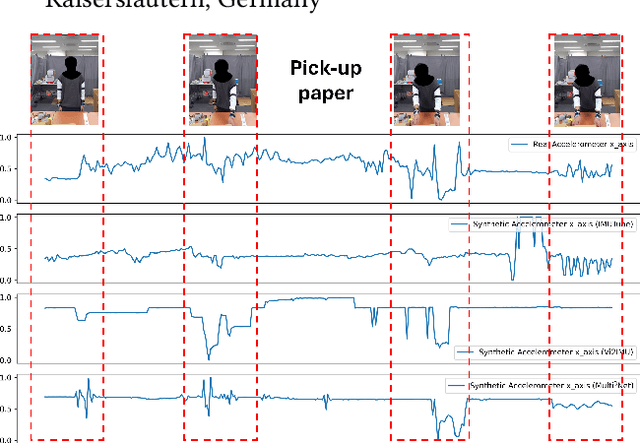
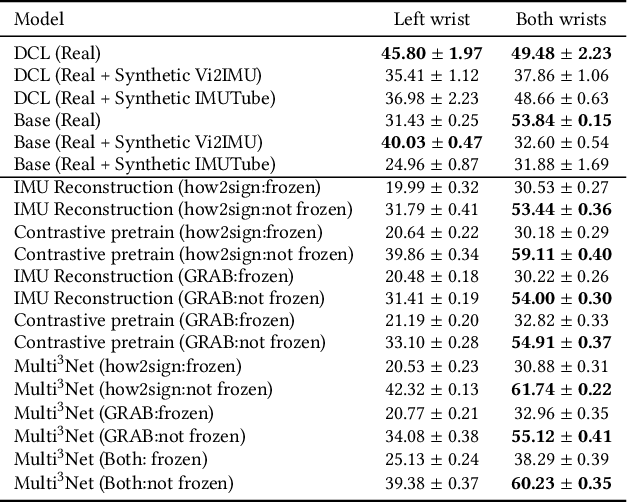
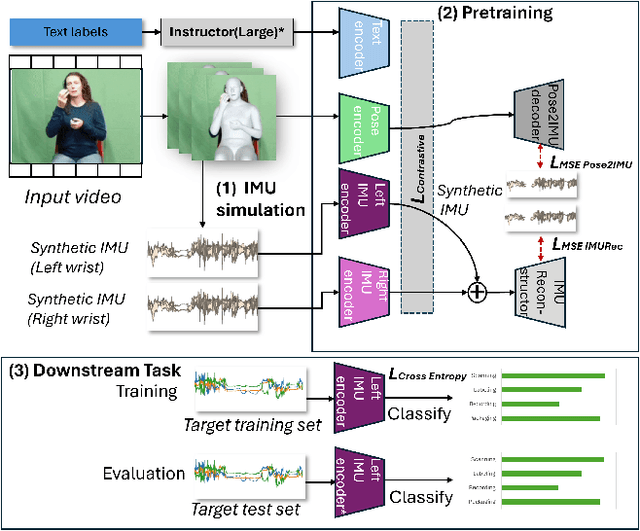
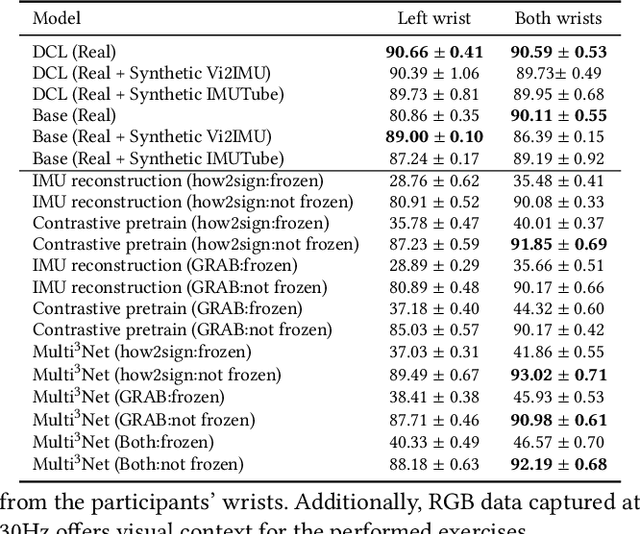
Abstract:Due to the scarcity of labeled sensor data in HAR, prior research has turned to video data to synthesize Inertial Measurement Units (IMU) data, capitalizing on its rich activity annotations. However, generating IMU data from videos presents challenges for HAR in real-world settings, attributed to the poor quality of synthetic IMU data and its limited efficacy in subtle, fine-grained motions. In this paper, we propose Multi$^3$Net, our novel multi-modal, multitask, and contrastive-based framework approach to address the issue of limited data. Our pretraining procedure uses videos from online repositories, aiming to learn joint representations of text, pose, and IMU simultaneously. By employing video data and contrastive learning, our method seeks to enhance wearable HAR performance, especially in recognizing subtle activities.Our experimental findings validate the effectiveness of our approach in improving HAR performance with IMU data. We demonstrate that models trained with synthetic IMU data generated from videos using our method surpass existing approaches in recognizing fine-grained activities.
PhysMLE: Generalizable and Priors-Inclusive Multi-task Remote Physiological Measurement
May 10, 2024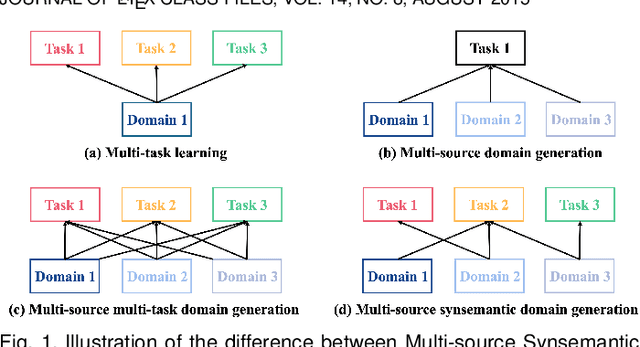

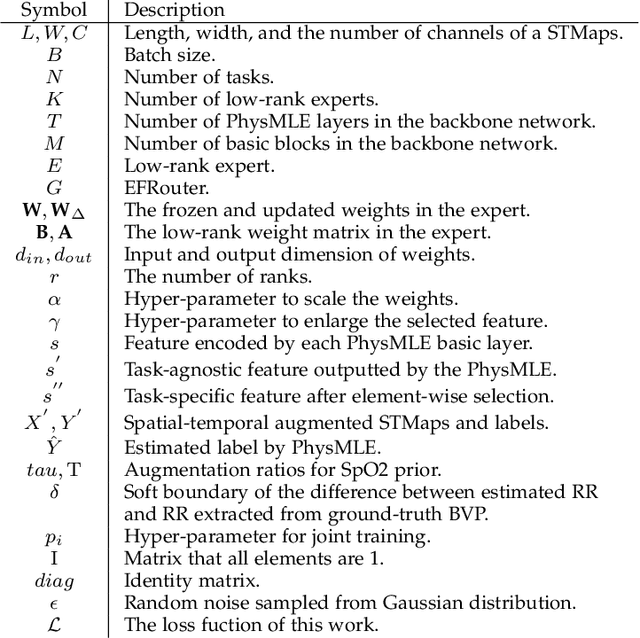
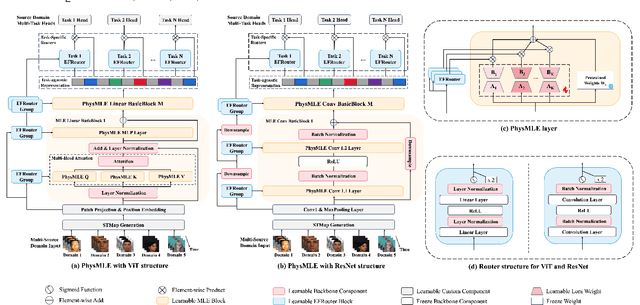
Abstract:Remote photoplethysmography (rPPG) has been widely applied to measure heart rate from face videos. To increase the generalizability of the algorithms, domain generalization (DG) attracted increasing attention in rPPG. However, when rPPG is extended to simultaneously measure more vital signs (e.g., respiration and blood oxygen saturation), achieving generalizability brings new challenges. Although partial features shared among different physiological signals can benefit multi-task learning, the sparse and imbalanced target label space brings the seesaw effect over task-specific feature learning. To resolve this problem, we designed an end-to-end Mixture of Low-rank Experts for multi-task remote Physiological measurement (PhysMLE), which is based on multiple low-rank experts with a novel router mechanism, thereby enabling the model to adeptly handle both specifications and correlations within tasks. Additionally, we introduced prior knowledge from physiology among tasks to overcome the imbalance of label space under real-world multi-task physiological measurement. For fair and comprehensive evaluations, this paper proposed a large-scale multi-task generalization benchmark, named Multi-Source Synsemantic Domain Generalization (MSSDG) protocol. Extensive experiments with MSSDG and intra-dataset have shown the effectiveness and efficiency of PhysMLE. In addition, a new dataset was collected and made publicly available to meet the needs of the MSSDG.
CODA: A COst-efficient Test-time Domain Adaptation Mechanism for HAR
Mar 22, 2024Abstract:In recent years, emerging research on mobile sensing has led to novel scenarios that enhance daily life for humans, but dynamic usage conditions often result in performance degradation when systems are deployed in real-world settings. Existing solutions typically employ one-off adaptation schemes based on neural networks, which struggle to ensure robustness against uncertain drifting conditions in human-centric sensing scenarios. In this paper, we propose CODA, a COst-efficient Domain Adaptation mechanism for mobile sensing that addresses real-time drifts from the data distribution perspective with active learning theory, ensuring cost-efficient adaptation directly on the device. By incorporating a clustering loss and importance-weighted active learning algorithm, CODA retains the relationship between different clusters during cost-effective instance-level updates, preserving meaningful structure within the data distribution. We also showcase its generalization by seamlessly integrating it with Neural Network-based solutions for Human Activity Recognition tasks. Through meticulous evaluations across diverse datasets, including phone-based, watch-based, and integrated sensor-based sensing tasks, we demonstrate the feasibility and potential of online adaptation with CODA. The promising results achieved by CODA, even without learnable parameters, also suggest the possibility of realizing unobtrusive adaptation through specific application designs with sufficient feedback.
Advancing Generalizable Remote Physiological Measurement through the Integration of Explicit and Implicit Prior Knowledge
Mar 11, 2024



Abstract:Remote photoplethysmography (rPPG) is a promising technology that captures physiological signals from face videos, with potential applications in medical health, emotional computing, and biosecurity recognition. The demand for rPPG tasks has expanded from demonstrating good performance on intra-dataset testing to cross-dataset testing (i.e., domain generalization). However, most existing methods have overlooked the prior knowledge of rPPG, resulting in poor generalization ability. In this paper, we propose a novel framework that simultaneously utilizes explicit and implicit prior knowledge in the rPPG task. Specifically, we systematically analyze the causes of noise sources (e.g., different camera, lighting, skin types, and movement) across different domains and incorporate these prior knowledge into the network. Additionally, we leverage a two-branch network to disentangle the physiological feature distribution from noises through implicit label correlation. Our extensive experiments demonstrate that the proposed method not only outperforms state-of-the-art methods on RGB cross-dataset evaluation but also generalizes well from RGB datasets to NIR datasets. The code is available at https://github.com/keke-nice/Greip.
On Designing Multi-UAV aided Wireless Powered Dynamic Communication via Hierarchical Deep Reinforcement Learning
Dec 13, 2023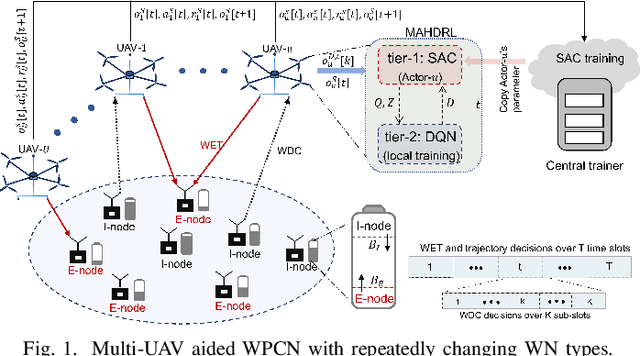
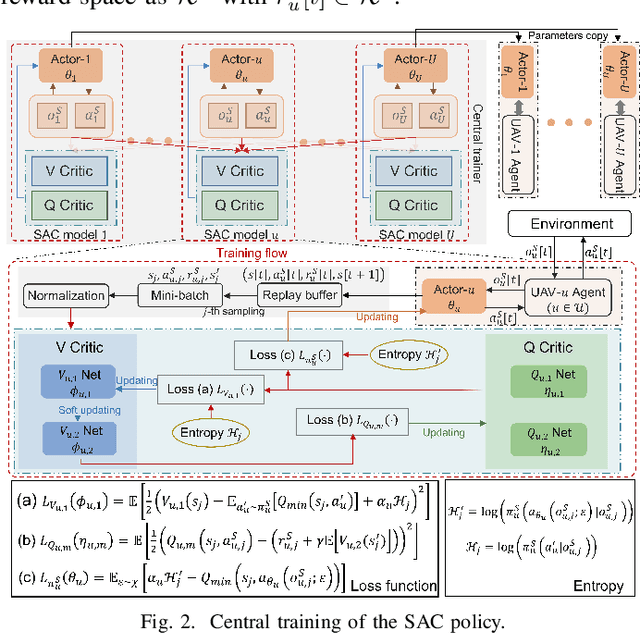
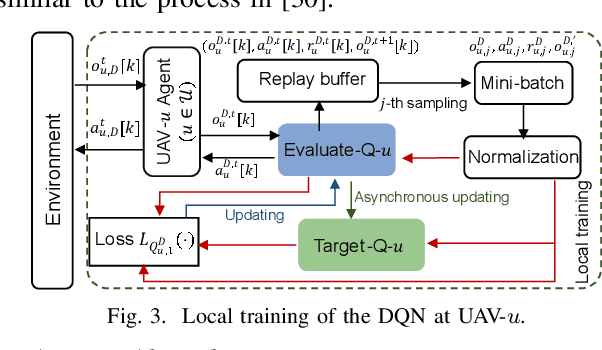
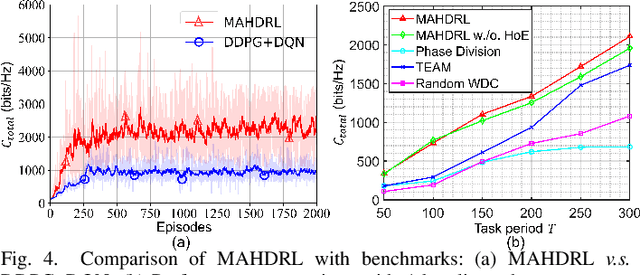
Abstract:This paper proposes a novel design on the wireless powered communication network (WPCN) in dynamic environments under the assistance of multiple unmanned aerial vehicles (UAVs). Unlike the existing studies, where the low-power wireless nodes (WNs) often conform to the coherent harvest-then-transmit protocol, under our newly proposed double-threshold based WN type updating rule, each WN can dynamically and repeatedly update its WN type as an E-node for non-linear energy harvesting over time slots or an I-node for transmitting data over sub-slots. To maximize the total transmission data size of all the WNs over T slots, each of the UAVs individually determines its trajectory and binary wireless energy transmission (WET) decisions over times slots and its binary wireless data collection (WDC) decisions over sub-slots, under the constraints of each UAV's limited on-board energy and each WN's node type updating rule. However, due to the UAVs' tightly-coupled trajectories with their WET and WDC decisions, as well as each WN's time-varying battery energy, this problem is difficult to solve optimally. We then propose a new multi-agent based hierarchical deep reinforcement learning (MAHDRL) framework with two tiers to solve the problem efficiently, where the soft actor critic (SAC) policy is designed in tier-1 to determine each UAV's continuous trajectory and binary WET decision over time slots, and the deep-Q learning (DQN) policy is designed in tier-2 to determine each UAV's binary WDC decisions over sub-slots under the given UAV trajectory from tier-1. Both of the SAC policy and the DQN policy are executed distributively at each UAV. Finally, extensive simulation results are provided to validate the outweighed performance of the proposed MAHDRL approach over various state-of-the-art benchmarks.
Self-Convinced Prompting: Few-Shot Question Answering with Repeated Introspection
Oct 10, 2023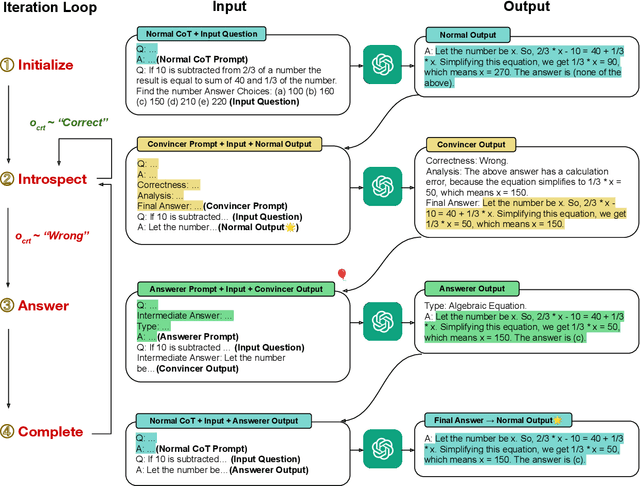
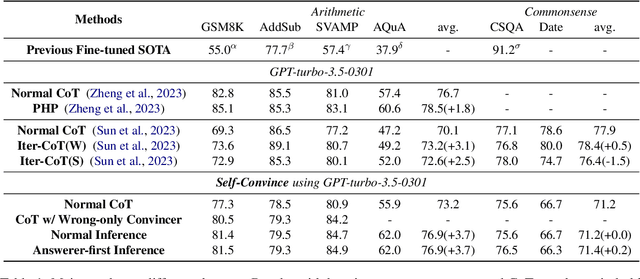
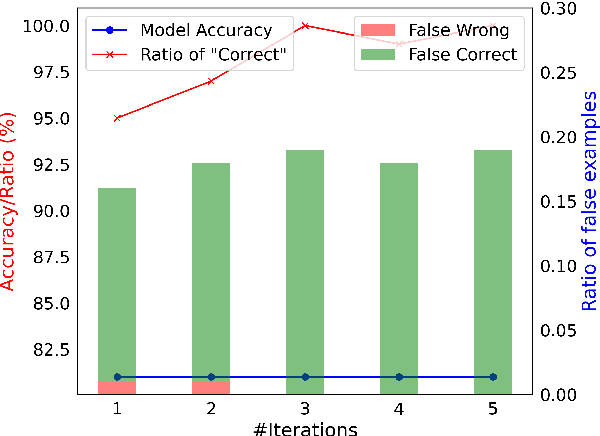

Abstract:While large language models (LLMs) such as ChatGPT and PaLM have demonstrated remarkable performance in various language understanding and generation tasks, their capabilities in complex reasoning and intricate knowledge utilization still fall short of human-level proficiency. Recent studies have established the effectiveness of prompts in steering LLMs towards generating desired outputs. Building on these insights, we introduce a novel framework that harnesses the potential of large-scale pre-trained language models, to iteratively enhance performance of the LLMs. Our framework incorporates three components: \textit{Normal CoT}, a \textit{Convincer}, and an \textit{Answerer}. It processes the output of a typical few-shot chain-of-thought prompt, assesses the correctness of the response, scrutinizes the answer, refines the reasoning, and ultimately produces a new solution. Experimental results on the 7 datasets of miscellaneous problems validate the efficacy of the Self-Convince framework, achieving substantial improvements compared to the baselines. This study contributes to the burgeoning body of research focused on integrating pre-trained language models with tailored prompts and iterative refinement processes to augment their performance in complex tasks.
Task-Oriented Integrated Sensing, Computation and Communication for Wireless Edge AI
Jun 11, 2023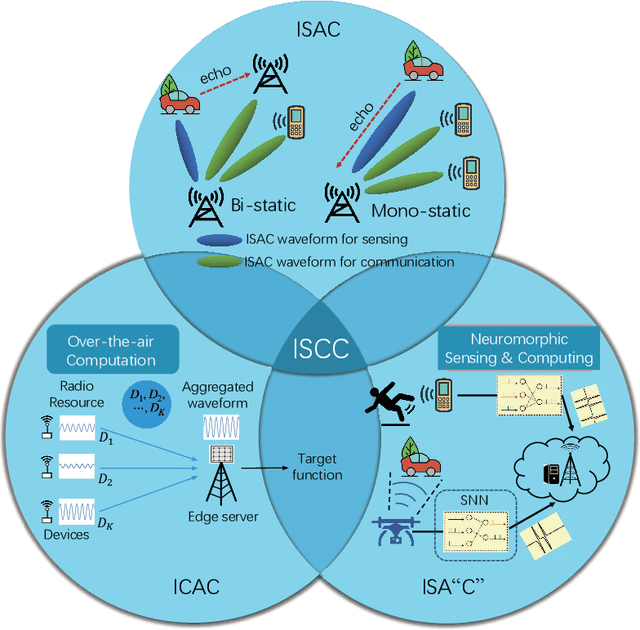
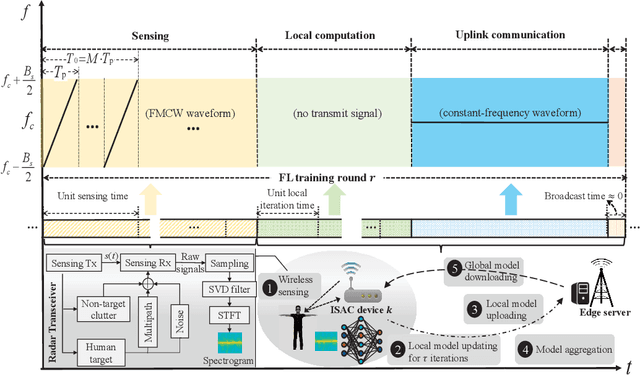
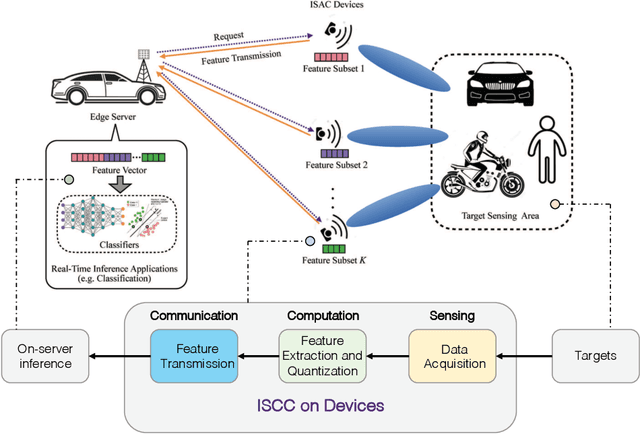
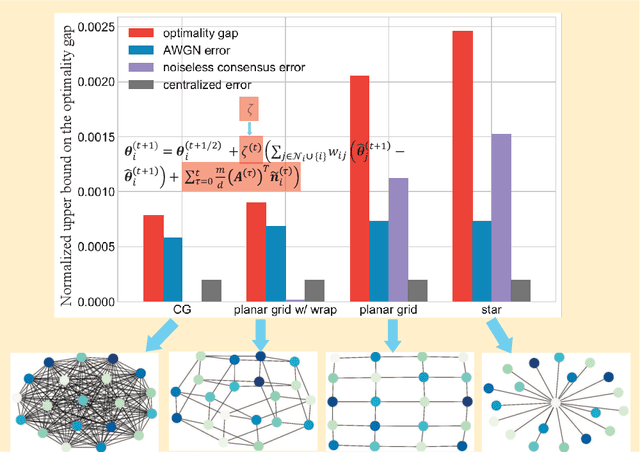
Abstract:With the advent of emerging IoT applications such as autonomous driving, digital-twin and metaverse etc. featuring massive data sensing, analyzing and inference as well critical latency in beyond 5G (B5G) networks, edge artificial intelligence (AI) has been proposed to provide high-performance computation of a conventional cloud down to the network edge. Recently, convergence of wireless sensing, computation and communication (SC${}^2$) for specific edge AI tasks, has aroused paradigm shift by enabling (partial) sharing of the radio-frequency (RF) transceivers and information processing pipelines among these three fundamental functionalities of IoT. However, most existing design frameworks separate these designs incurring unnecessary signaling overhead and waste of energy, and it is therefore of paramount importance to advance fully integrated sensing, computation and communication (ISCC) to achieve ultra-reliable and low-latency edge intelligence acquisition. In this article, we provide an overview of principles of enabling ISCC technologies followed by two concrete use cases of edge AI tasks demonstrating the advantage of task-oriented ISCC, and pointed out some practical challenges in edge AI design with advanced ISCC solutions.
 Add to Chrome
Add to Chrome Add to Firefox
Add to Firefox Add to Edge
Add to Edge